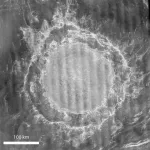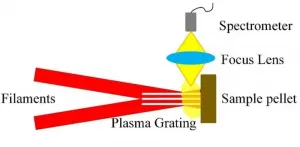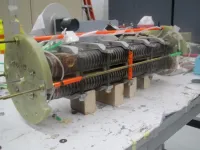Transportation investments could save hundreds of lives, billions of dollars
Health-related savings from increased walking and bicycling far exceed the estimated infrastructure costs
2021-01-28
(Press-News.org) BOSTON - Investments in infrastructure to promote bicycling and walking could save as many as 770 lives and $7.6 billion each year across 12 northeastern states and the District of Columbia under the proposed Transportation and Climate Initiative (TCI), according to a new Boston University School of Public Health (BUSPH) and Harvard T.H. Chan School of Public Health study.
Published in the Journal of Urban Health, the analysis shows that the monetary benefit of lives saved from increased walking and cycling far exceed the estimated annual investment for such infrastructure, without even considering the added benefits of reducing air pollution and tackling climate change.
"Our study suggests that if all the states joined TCI and collectively invested at least $100 million in active mobility infrastructure and public transit, the program could save hundreds of lives per year from increased physical activity. These benefits are larger than the estimated air quality and climate benefits for the TCI scenarios, highlighting the importance of leveraging investments in sustainable active mobility to improve health," says study lead author Matthew Raifman, a doctoral student in environmental health at BUSPH.
The TCI program, a partnership of 12 states and the District of Columbia currently under development, would implement a cap-and-invest program to reduce transportation sector emissions across the Northeast and Mid-Atlantic region, including substantial investment in cycling and pedestrian infrastructure as well as other sustainable transportation strategies like electric vehicle charging and public transit. In December, Massachusetts, Connecticut, Rhode Island, and D.C. became the first jurisdictions to formally join the TCI program.
Raifman and colleagues used an investment scenario model and the World Health Organization (WHO) Health Economic Assessment Tool methodology to estimate how many lives would be saved in each of the 378 counties in the Northeast and Mid-Atlantic regions thanks to increased physical activity (walking/running and cycling) and accounting for the potential for changes in traffic fatalities.
"These findings demonstrate how investments in climate-friendly transportation options like biking and walking can reap huge health and economic benefits at the local level," says study senior author Dr. Patrick Kinney, Beverly A. Brown Professor for the Improvement of Urban Health at BUSPH.
The team analyzed nine scenarios that differed in their greenhouse gas emission caps as well as how the proceeds from the program would be invested across a range of transportation options. The scenario with the largest health benefits assumed a 25% reduction in greenhouse gas emissions, and investment of $632 million of the proceeds in cycling and pedestrian infrastructure across the 12 states and D.C. The researchers estimated that this scenario could save 770 lives regionwide due to reduced cardiovascular mortality, accounting for changes in pedestrian accident fatality rates. The monetary value of the reduced health risk is $7.6 billion per year.
Health benefits across the other scenarios roughly scaled with the degree of investment in pedestrian and cycling infrastructure. For example, a more modest scenario highlighted in the December 2020 TCI memorandum of understanding (MOU) would invest $130 million in cycling and pedestrian infrastructure, saving around 200 lives regionwide due to increased physical activity, with a monetary value of $1.8 billion. The four jurisdictions that signed the MOU thus far would see 16 lives saved each year from biking and walking under the MOU scenario, with a monetized value of $154 million, the researchers estimated.
The states with the largest estimated health benefits from active mobility under all policy scenarios are the populous states of New York, New Jersey, Pennsylvania, and Maryland.
"Investments in active mobility would not only increase physical activity but would also reduce air pollution levels and start to address the climate crisis. This study reinforces the importance of considering near-term health benefits when developing climate policy," says study co-author Dr. Jonathan Levy, professor and chair of environmental health at BUSPH.
"Given the legacy of inequitable investment in infrastructure in the United States, the opportunity exists to address racial disparities in access to sidewalks and cycling infrastructure through equity-focused project siting," Raifman says.
The study is part of the Transportation, Equity, Climate and Health (TRECH) Project, a multi-university research initiative independently analyzing TCI and other policy scenarios. TRECH is based at the Center for Climate, Health, and the Global Environment at Harvard T.H. Chan School of Public Health (Harvard Chan C-CHANGE).
"This study sheds light on potential health benefits from investments in biking and walking infrastructure. Actual outcomes will depend on how much funding exists and how it is invested. We hope this information is useful to policymakers and advocates as they consider how to best target transportation investments to gain greater and more equitable health benefits," says study co-author Kathy Fallon Lambert, senior advisor at Harvard Chan C-CHANGE.
INFORMATION:
The TRECH Project is made possible in part by a grant from the Barr Foundation to the Center for Climate, Health, and the Global Environment at the Harvard T.H. Chan School of Public Health.
About the Boston University School of Public Health
Founded in 1976, the Boston University School of Public Health is one of the top five ranked private schools of public health in the world. It offers master's- and doctoral-level education in public health. The faculty in six departments conduct policy-changing public health research around the world, with the mission of improving the health of populations--especially the disadvantaged, underserved, and vulnerable--locally and globally.
ELSE PRESS RELEASES FROM THIS DATE:
2021-01-28
DURHAM, N.C. -- Malaria is an ancient scourge, but it's still leaving its mark on the human genome. And now, researchers have uncovered recent traces of adaptation to malaria in the DNA of people from Cabo Verde, an island nation off the African coast.
An archipelago of ten islands in the Atlantic Ocean some 385 miles offshore from Senegal, Cabo Verde was uninhabited until the mid-1400s, when it was colonized by Portuguese sailors who brought enslaved Africans with them and forced them to work the land.
The Africans who were forcibly brought to Cabo Verde carried ...
2021-01-28
CHAPEL HILL, NC - Many molecules in our bodies help our immune system keep us healthy without overreacting so much that our immune cells cause problems, such as autoimmune diseases. One molecule, called AIM2, is part of our innate immunity - a defense system established since birth - to fight pathogens and keep us healthy. But little was known about AIM2's contribution to T cell adaptive immunity - defenses developed in response to particular pathogens and health problems we develop over the course of our lives.
Now, UNC School of Medicine scientists led by Jenny Ting, PhD, the William Kenan Distinguished Professor of Genetics, and Yisong Wan, PhD, professor of microbiology and immunology, discovered that AIM2 is important for the proper function of regulatory ...
2021-01-28
DURHAM, N.C. -- When their manhood is threatened, some men respond aggressively, but not all. New research from Duke University suggests who may be most triggered by such threats - younger men whose sense of masculinity depends heavily on other people's opinions.
"Our results suggest that the more social pressure a man feels to be masculine, the more aggressive he may be," said Adam Stanaland, a Ph.D. candidate in psychology and public policy at Duke and the study's lead author.
"When those men feel they are not living up to strict gender norms, they may feel the need to act aggressively to prove their manhood -- to 'be a man'."
The pair of studies considered 195 undergraduate students and a random pool of 391 men ages 18 to 56.
Study participants were asked a series ...
2021-01-28
Tiny molecular forces at the surface of water droplets can play a big role in laser output emissions. As the most fundamental matrix of life, water drives numerous essential biological activities, through interactions with biomolecules and organisms. Studying the mechanical effects of water-involved interactions contributes to the understanding of biochemical processes. According to Yu-Cheng Chen, professor of electronic engineering at Nanyang Technological University (NTU), "As water interacts with a surface, the hydrophobicity at the bio-interface mainly determines the mechanical equilibrium ...
2021-01-28
PROVIDENCE, R.I. [Brown University] -- At some point between 300 million and 1 billion years ago, a large cosmic object smashed into the planet Venus, leaving a crater more than 170 miles in diameter. A team of Brown University researchers has used that ancient impact scar to explore the possibility that Venus once had Earth-like plate tectonics.
For a study published in Nature Astronomy, the researchers used computer models to recreate the impact that carved out Mead crater, Venus's largest impact basin. Mead is surrounded by two clifflike faults -- rocky ripples frozen in time after the basin-forming impact. The models showed that for those rings to be where they ...
2021-01-28
BOSTON-Boston Medical Center has released a study that shows post overdose outreach programs in Massachusetts have expanded across the state, as 44 percent of municipalities reported having such programs available - a majority established since 2015 - to reduce risks for those who survive an overdose. The results are published online in the February 2021 issue of Drug and Alcohol Dependence.
These post-overdose outreach programs leverage collaborations between public health overdose prevention practitioners and public safety organizations (police, fire, EMS) to engage overdose survivors and/or their social networks (family, friends, and acquaintances) at their home one to three days after an overdose. ...
2021-01-28
Laser-induced breakdown spectroscopy (LIBS) is a rapid chemical analysis tool. A powerful laser pulse is focused on a sample to create a microplasma. The elemental or molecular emission spectra from that microplasma can be used to determine the elemental composition of the sample.
Compared with more traditional technology, like atomic absorption spectroscopy and inductively coupled plasma optical emission spectroscopy (ICP-OES), LIBS has some unique advantages: no sample pretreatment, simultaneous multi-element detection, and real-time noncontact measurements. These advantages make it suitable for practical analysis of solids, gases, and liquids.
Traditional LIBS and extensions
Traditional ...
2021-01-28
The study of warm dense matter helps us understand what is going on inside giant planets, brown dwarfs, and neutron stars. However, this state of matter, which exhibits properties of both solids and plasmas, does not occur naturally on Earth. It can be produced artificially in the lab using large X-ray experiments, albeit only at a small scale and for short periods of time. Theoretical and numerical models are essential to evaluate these experiments, which are impossible to interpret without formulas, algorithms, and simulations. Scientists at the Center for Advanced Systems Understanding (CASUS) at the Helmholtz-Zentrum Dresden-Rossendorf (HZDR) have now developed a method to evaluate such ...
2021-01-28
With a powerful enough light, you can see things that people once thought would be impossible. Large-scale light source facilities generate that powerful light, and scientists use it to create more durable materials, build more efficient batteries and computers, and learn more about the natural world.
When it comes to building these massive facilities, space is money. If you can get higher-energy beams of light out of smaller devices, you can save millions on construction costs. Add to that the chance to significantly improve the capabilities of existing light sources, and you have the motivation behind a project that has brought scientists at three U.S. Department of Energy national laboratories together.
This team has just achieved an important milestone ...
2021-01-28
Attempts to identify the genetic causes of neuropsychiatric diseases such as post-traumatic stress disorder (PTSD) through large-scale genome-wide analyses have yielded thousands of potential links. The challenge is further complicated by the wide range of symptoms exhibited by those who have PTSD. For instance, does extreme arousal, anger, or irritation experienced by some have the same genetic basis as the tendency to re-experience traumatic events, another symptom of the disorder?
A new study led by researchers at Yale and the University of California-San Diego (UCSD) provides answers to some of these questions and uncovers intriguing genetic similarities between PTSD and other mental health disorders such as anxiety, bipolar disorder, and schizophrenia. ...
LAST 30 PRESS RELEASES:
[Press-News.org] Transportation investments could save hundreds of lives, billions of dollars
Health-related savings from increased walking and bicycling far exceed the estimated infrastructure costs




